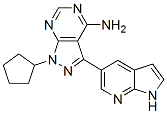
PP121 is a dual inhibitor of receptor tyrosine kinases (RTKs) (IC50 < 0.02 μM for Abl, Src, VEGFR-2 and PDGFR) and PI 3-K family kinases (IC50 < 0.06 μM for p110α, DNA-PK and mTOR). PP121 is the first inhibitor active on both Tyrosine kinases and the phosphatidylinositol-3-OH kinase (PI(3)K) family. PP121 blocks the proliferation of tumor cells by direct inhibition of PI 3-K, mTOR, Src and the VEGF receptor. PP-121 induces a G0/G1 arrest in LN220, U87 and Seg1 cells. PP-121 directly inhibits Bcr-Abl induced tyrosine phosphorylation, resulting in drug-induced apoptosis in K562 cells and a combination of apoptosis and cell cycle arrest in Bcr-Abl expressing BaF3 cells. PP-121 also inhibits other PI3Ks including p110α and DNA-PK with IC50 of 52 nM and 60 nM, respectively.
| Cell Experiment | |
|---|---|
| Cell lines | U87 and LN229 cells line |
| Preparation method | Cell proliferation assays. Cells grown in 96-well plates were treated with inhibitor at 4-fold dilutions (10 µM - 0.040 μM) or vehicle (0.1% DMSO). After 72 h cells were exposed to Resazurin sodium salt (22 µM, Sigma) and fluorescence was quantified. IC50 values were calculated using Prism software. For proliferation assays involving single cell counting, non-adherent cells were plated at low density (3–5% confluence) and treated with drug (2.5 µM) or vehicle (0.1% DMSO). Cells were diluted into trypan blue daily and viable cells counted using a hemocytometer. |
| Concentrations | 10 µM - 0.040 μM |
| Incubation time | 72 h |
| Animal Experiment | |
|---|---|
| Animal models | Eca-109 cells Mice xenograft |
| Formulation | 10% 1-methyl-2-pyrrolidinone and 90% PEG 300 |
| Dosages | 30 mg/kg daily for 30 days |
| Administration | oral gavage |
| Molecular Weight | 319.36 |
| Formula | C17H17N7 |
| CAS Number | 1092788-83-4 |
| Solubility (25°C) | DMSO 60 mg/mL |
| Storage |
Powder -20°C 3 years ; 4°C 2 years In solvent -80°C 6 months ; -20°C 1 month |
| Species | Mouse | Rat | Rabbit | Guinea pig | Hamster | Dog |
| Weight (kg) | 0.02 | 0.15 | 1.8 | 0.4 | 0.08 | 10 |
| Body Surface Area (m2) | 0.007 | 0.025 | 0.15 | 0.05 | 0.02 | 0.5 |
| Km factor | 3 | 6 | 12 | 8 | 5 | 20 |
| Animal A (mg/kg) = Animal B (mg/kg) multiplied by | Animal B Km |
| Animal A Km |
For example, to modify the dose of Compound A used for a mouse (20 mg/kg) to a dose based on the BSA for a rat, multiply 20 mg/kg by the Km factor for a mouse and then divide by the Km factor for a rat. This calculation results in a rat equivalent dose for Compound A of 10 mg/kg.
| Related VEGFR/PDGFR Products |
|---|
| Isolinderalactone
Isolinderalactone suppresses human glioblastoma growth and angiogenic activity through the inhibition of VEGFR2 activation in endothelial cells. Isolinderalactone suppressed the expression of B-cell lymphoma 2 (BCL-2), as well as of survivin and X-linked inhibitor of apoptosis protein (XIAP). |
| Oglufanide
Oglufanide (H-Glu-Trp-OH) is a dipeptide immunomodulator isolated from calf thymus. |
| KLTWQELYQLKYKGI
KLTWQELYQLKYKGI (QK) is a VEGF mimicking peptide, binds to the VEGF receptors and competes with VEGF. |
| Protein LMWP
Protein LMWP is a cell-penetrating peptide with vascular endothelial growth factor (VEGF) inhibitory activity. |
| CBO-P11
CBO-P11 specifically binds to receptor of VEGFR-2 and is used as targeting ligand for tumor angiogenesis. |


Products are for research use only. Not for human use. We do not sell to patients.
© Copyright 2010-2023 AbMole BioScience. All Rights Reserved.
